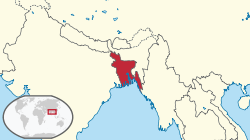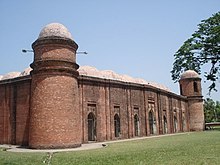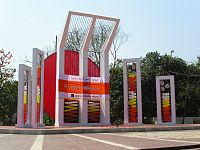Bangladẹ́shì
People's Republic of Bangladesh গণপ্রজাতন্ত্রী বাংলাদেশ Gônoprojatontri Bangladesh | |
|---|---|
 | |
| Olùìlú àti ìlú tótóbijùlọ | Dhaka |
| Àwọn èdè ìṣẹ́ọba | Bangla |
| Orúkọ aráàlú | Bangladeshi |
| Ìjọba | Parliamentary republic[1] |
| Zillur Rahman | |
| Sheikh Hasina Wazed | |
• Speaker | Ad.Abdul Hamid |
| Independence from Pakistan | |
• Declared | March 26, 1971 |
| Ìtóbi | |
• Total | 147,570 km2 (56,980 sq mi) (94th) |
• Omi (%) | 7.0 |
| Alábùgbé | |
• 2009 estimate | 162,221,000[2] (7th) |
• Ìdìmọ́ra | 1,099.3/km2 (2,847.2/sq mi) (5th) |
| GDP (PPP) | 2009 estimate |
• Total | $226.205 billion[3] (48th) |
• Per capita | $1,398[3] (153rd) |
| GDP (nominal) | 2008 estimate |
• Total | $84.196 billion[3] (58th) |
• Per capita | $690[4] (147th) |
| Gini (2000) | 33.4 medium |
| HDI (2007) | ▲ 0.543[5] Error: Invalid HDI value · 146th |
| Owóníná | Taka (BDT) |
| Ibi àkókò | UTC+6 (BST) |
| Ojúọ̀nà ọkọ́ | left |
| Àmì tẹlifóònù | 880 |
| Internet TLD | .bd |
| |
![]() Bangladesh (ìrànwọ́·ìkéde) (Bengali: বাংলাদেশ, pronounced [ˈbaŋlad̪eʃ]; Bangladesh), fun ibise gege bi orile-ede Olominira Araalu ile Bangladesh (Bengali: গণপ্রজাতন্ত্রী বাংলাদেশ Gônoprojatontri Bangladesh) je orile-ede kan ni Guusu Asia. O ni bode mo India ni gbogbo awon egbe re ayafi fun bode kekere mo Burma (Myanmar) ni guusuilaorun ati mo Ebado Bengal ni guusu. Lapapo mo ipinle West Bengal ni India, o je agbegbe eya-ede Bengal. Oruko Bangladesh tumosi "Orile-ede ile Bengal" ni ede ibise Bengal.
Bangladesh (ìrànwọ́·ìkéde) (Bengali: বাংলাদেশ, pronounced [ˈbaŋlad̪eʃ]; Bangladesh), fun ibise gege bi orile-ede Olominira Araalu ile Bangladesh (Bengali: গণপ্রজাতন্ত্রী বাংলাদেশ Gônoprojatontri Bangladesh) je orile-ede kan ni Guusu Asia. O ni bode mo India ni gbogbo awon egbe re ayafi fun bode kekere mo Burma (Myanmar) ni guusuilaorun ati mo Ebado Bengal ni guusu. Lapapo mo ipinle West Bengal ni India, o je agbegbe eya-ede Bengal. Oruko Bangladesh tumosi "Orile-ede ile Bengal" ni ede ibise Bengal.
Awon bode Bangladesh lowolowo loni je didasile pelu ipinya Bengal ati India ni 1947, nigbati agbegbe na di egbe apailaorun orile-ede tuntun Pakistan. Sugbon, o pinsoto lati egbe apaiworun pelu 1,600 km (994 mi) ile India. Nitori idawaloto oloselu ati ede ati aisi okowo to fa isodi awon araalu si Iwoorun Pakistan, to fa ogun fun ilominira ni 1971 ati idasile orile-ede Bangladesh. Leyin ilominira orile-ede tuntun yi koju iyan, ajalu eda ati aini togbale, ati wahala oselu ati igbajoba ologun. Ipadade oseluaraalu ni 1991 mu itoro ati idagbasoke okowo wa.
Bangladesh ni orile-ede keje to lopo eniyan julo ati ikan ninu awon orile-ede to lopo eniyan kikijulo laye pelu osuwon aini giga. Sibesibe, GDP ti enikookan ti di emeji lati 1975, be sini osuwon aini ti re bi 20% lati ibere awon odun 1990. Bangladesh je ikan ninu awon orile-ede ti a npe ni okowo "Next Eleven". Dhaka, oluilu re, ati awon gbongan igboro ilu miran kopa ninu idagbasoke yi.[6]
Fun jeografi, orile-ede yi gba ile olora Delta Ganges-Brahmaputra be sini oun ni omoyale lododun ojo monsoon ati iji birikiti. Bangladesh ni ile yepe eti-odo to gunjulo laye ni ti Cox's Bazaar. Oselu re ni oseluaralu ile-asofin. Bangladesh je ikan ninu Ajoni awon Orile-ede, OIC, SAARC, BIMSTEC, ati D-8. Gege bi Banki Agbaye se sakiyesi ninu Oro nisoki Orile-ede re ni July 2005, Bangladesh ti ni ilosiwa gidi ni idagbasoke eniyan ni apa imookomooka, idogba ako/abo ni ile-eko ati iresile ipoju awon eniyan.[7] However, Bangladesh si nkoju awon isoro nla, ajakale iwaibaje awon oloselu ati osise ijoba, economic competition relative to the world, serious overpopulation, widespread poverty, and an increasing danger of hydrologic shocks brought on by ecological vulnerability to climate change.
Itan
[àtúnṣe | àtúnṣe àmìọ̀rọ̀]


Awon iseku asaolaju ni agbegbe Bengal loseyin de egberun merin odun,[8] nigbati ibe je titedo lowo awon Dravidian, Tibeto-Burman, ati awon Austro-Asiatic. Orisun oro Bangla" tabi "Bengal" ko je mimo, botilejepe won nigbagbo pe o wa lati Bang, eya to n sede Dravidian to budo si agbegbe yi larin odun 1000 kJ.[9]
Awon Itokasi
[àtúnṣe | àtúnṣe àmìọ̀rọ̀]- ↑ Constitution of Bangladesh Archived 2009-01-30 at the Wayback Machine., Part V, Chapter 1, Article 66.
- ↑ Department of Economic and Social Affairs Population Division (2009) (.PDF). World Population Prospects, Table A.1. 2008 revision. United Nations. http://www.un.org/esa/population/publications/wpp2008/wpp2008_text_tables.pdf. Retrieved 2009-03-12.
- ↑ 3.0 3.1 3.2 "Bangladesh". International Monetary Fund. Retrieved 2009-10-01.
- ↑ Bangladesh Bank, Annual Report 2008-09.
- ↑ "Human Development Report 2009. Human development index trends: Table G" (PDF). The United Nations. Retrieved 2009-10-05.
- ↑ "Sandeep Mahajan, "Bangladesh: Strategy for Sustained Growth", Poverty Reduction and Economic Management Network, World Bank (July 26, 2007)". Archived from the original on February 29, 2016. Retrieved April 20, 2010.
- ↑ Bangladesh – Country Brief Archived 2007-09-15 at the Wayback Machine., World Bank, July 2005
- ↑ Bharadwaj, G (2003). "The Ancient Period". In Majumdar, RC. History of Bengal. B.R. Publishing Corp.
- ↑ James Heitzman and Robert L. Worden, ed (1989). "Early History, 1000 B.C.-A.D. 1202". Bangladesh: A country study. Library of Congress. ISBN 8290584083. OCLC 15653912. http://memory.loc.gov/frd/cs/bdtoc.html.



